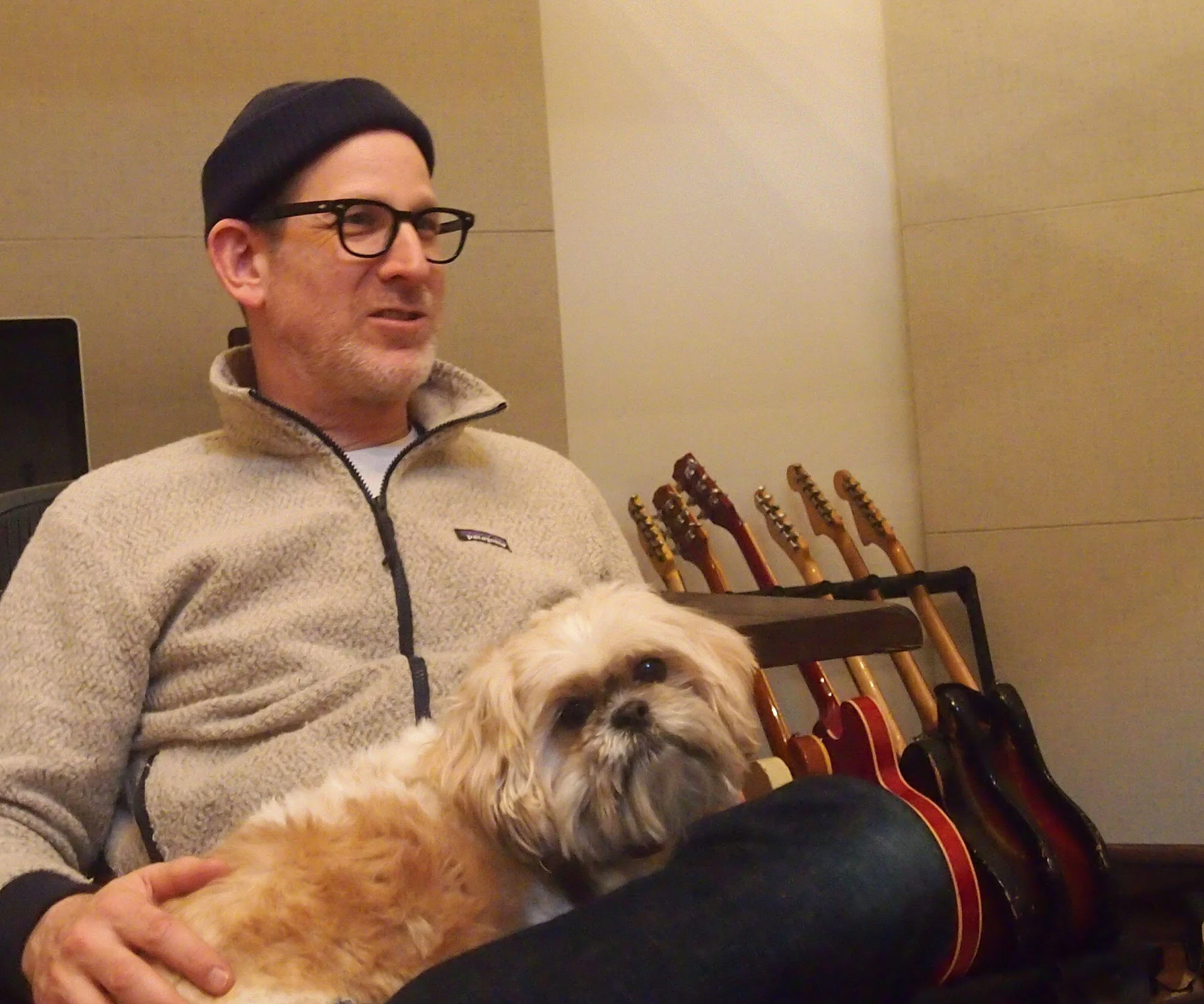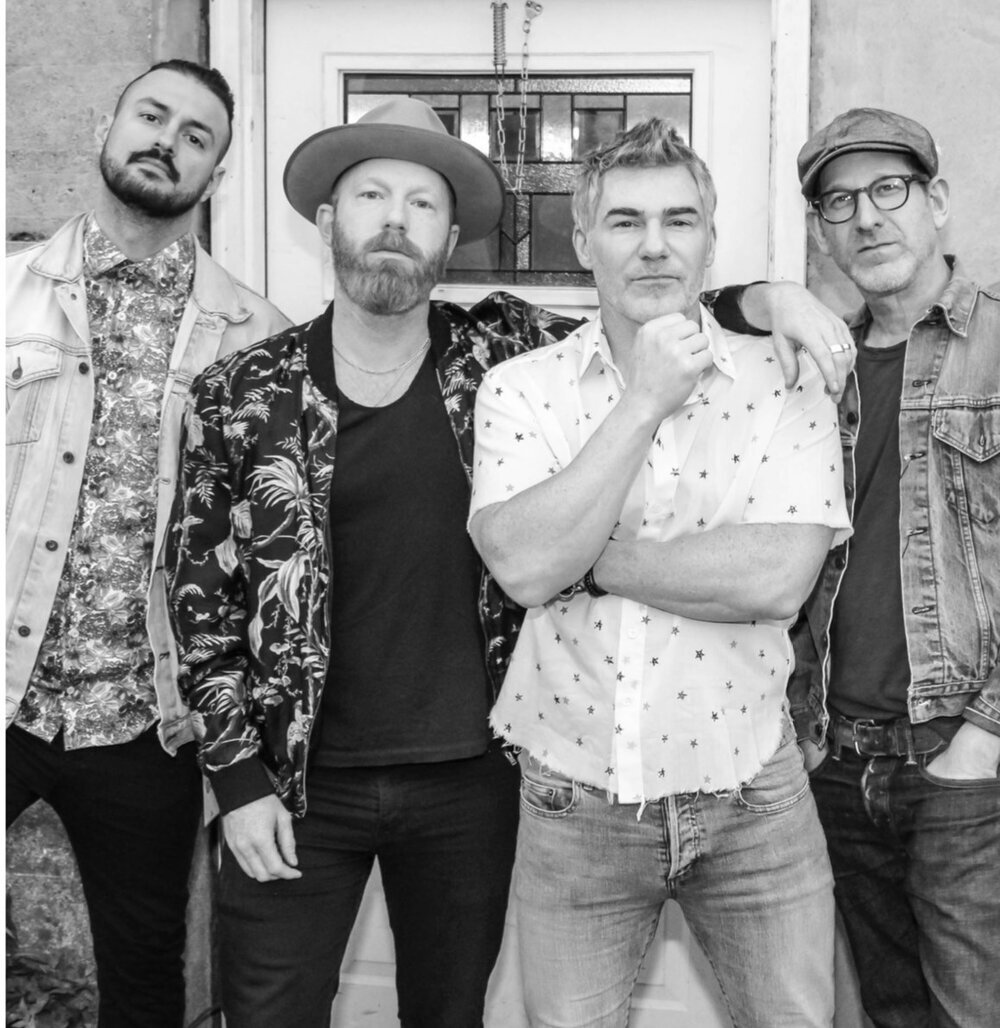The Bosstone Who Came to Town
Swarthmore guitarist Lawrence Katz in his home studio, relaxing with a blissful Elizabeth. Photo: Robert Richardson
When Lawrence Katz moved to Swarthmore, he built himself a small recording studio. He created the standard Macintosh-driven digital recording setup that has redefined the recording industry over the past couple of decades. But, Katz being a guitarist, there’s a clear guitar orientation to the room. Racks hold a variety of guitars for different shadings of tone. There’s the Stratocaster, Telecaster, and Les Paul you’d expect, but also some quirkier choices like a vintage sixties Fender Jaguar. You can tell from the variety that he does this for a living.
Since 2000, Katz has been a guitarist for the Mighty Mighty Bosstones, a group you most likely know for songs they recorded before Katz joined them, such as 1992’s “Where Did You Go?” or 1993’s “Someday I Suppose.” The band’s sound is sometimes punk overlaid with ska horns, sometimes straighter ska but with rock-and-roll guitar solos.
Before he joined the band, Katz was a session and gig musician in Los Angeles. “I was pretty diverse, stylistically,” he says, “but my ska knowledge was pretty limited to the obvious [groups]: Madness and the Specials, even the Police. I wouldn’t not have called myself a ska guy by any stretch, or punk rock guy for that matter.”
Ska-less Youth
Katz says ska was not at all on his radar when he picked up guitar as an elementary school kid in Atlanta. “I put it back down till high school, then realized that maybe it’s the only thing that I had any real motivation for.”
After high school, he attended Berklee College of Music in Boston, moving after graduation to Los Angeles to pick up work as a studio musician. In 2000, after the founding guitarist for the Bosstones quit, “they were having a hard time finding a replacement on the East Coast. Nobody really fit the bill. It’s an odd musical style, a blend of heavy punk rock and heavy ska. They were finding a lot of people who could do one or the other, but not both.”
Katz joined the band for tours following the release of their “Pay Attention” album. “It used to be that the band made its bread and butter doing 300 days on the road a year all over the world,” Katz notes. “Then there was a lot of upheaval in the music industry. Then 9/11 happened, and then everything was just turned over. So somewhere around 2004 we put the brakes on until 2007.”
It was invigorating to restart the band, Katz says, when “some of the dust had settled.” The group has since turned out three studio albums and a number of one-off projects. They play several concerts a year, occasionally mounting a two-week tour. “I think the band is better than it’s ever been.”
The Mighty Mighty Bosstones. Guitarist Lawrence Katz of Swarthmore third from left. Photo courtesy of the Mighty Mighty Bosstones.
The Mighty Mighty Bosstones play a nearly half-and-half mix of ska and punk. Even if you’ve never paid attention to ska, you still probably know it from early records by the Police, songs like “Don’t Stand So Close to Me” (currently enjoying a resurgence as a ballad for the pandemic). As for punk, the Bosstones’ music — simple chords played in fast succession with loads of distortion and the middle frequencies cranked high — brings the Ramones to mind. On tapes of Katz playing with the Bosstones, his studio musicianship comes through when his solos mute the unplayed strings with more control than a typical punk rocker would, leaving a clear melody even when he’s hitting the strings pretty hard in classic punk fashion.
Other Projects
Bosstone though he may be, Katz points out that work with the band “is a very small piece of the pie for me.” He frequently writes and produces with other collaborators. “I’m just constantly trying to churn out music.” With some partners, Katz creates music “kind of geared toward film and TV.” One project is called Graffiti Ghosts, and another is called Foxworth Hall. This interview took place before the COVID-19 outbreak, and he was getting ready to fly to Atlanta for a tour with yet another project, “a thing called Whole Damn Mess. It’s four producers just writing songs, recording them, touring.”
None of these projects, it’s worth noting, sounds like the Mighty Mighty Bosstones. Most of it lands more in the traditional rock spectrum.
Whole Damn Mess. Guitarist Lawrence Katz of Swarthmore on far right. Photo courtesy of the Whole Damn Mess.
The sound of Whole Damn Mess nods emphatically to the late eighties and early nineties, when top-charting songs were guitar-driven and percussion was played straight-ahead with nothing but the conventional drum kit. A song called “We Don’t Need a Reason” has a jangly, arpeggiated guitar with tones reminiscent of classic Luna tunes and a vocal line that calls to mind the Gin Blossoms, particularly “’Til I Hear It From You.”
Four producers who go out and tour? “In this day and age the word ‘producer’ is very vague,” Katz says. “We’re all just kind of multi-instrumentalists who record and produce.” Whole Damn Mess has also produced some interesting videos, including a three-song piece called “Redemption” that features (at least the outlines of) a plot in which an unshaven, somewhat strung-out guy drives around Los Angeles in an enormous old Cadillac convertible. These are available online and can be found with a quick Google of the band’s name.
Finding Swarthmore
Katz was living in Los Angeles in late 2007 when the band returned from its hiatus. He had married by then, and his wife, a fashion designer, was offered a key position at women’s clothing maker Free People. A move to the Philadelphia area was required. “Swarthmore just seemed like a great little landing spot,” Katz says.
But he adds: “The real answer why we’re in Swarthmore is [previously profiled Blind Melon guitarist] Rogers [Stevens], on some level. He should run the Chamber of Commerce.” Katz and his wife’s three-year-old daughter was also a factor: “It’s kind of paradise for a kid.”
And one other thing: “The city wasn’t necessarily an option because of this,” gesturing around the recording studio. I couldn’t have done this in the city. So we found Swarthmore.”






